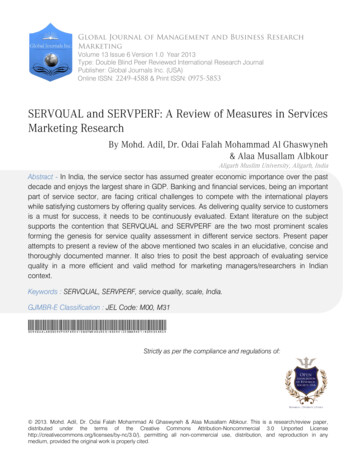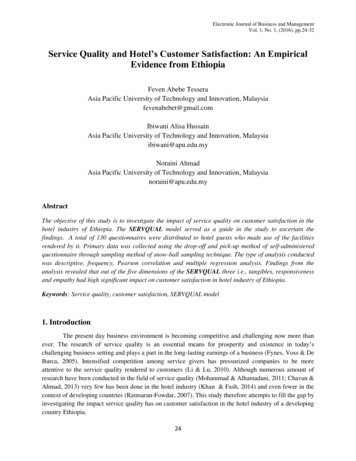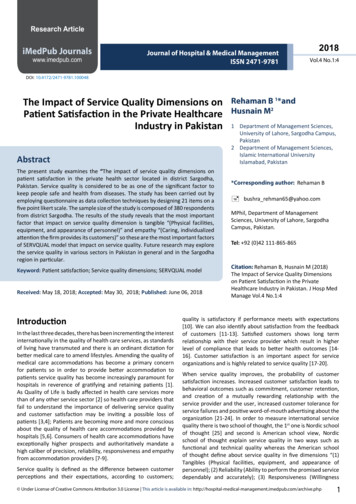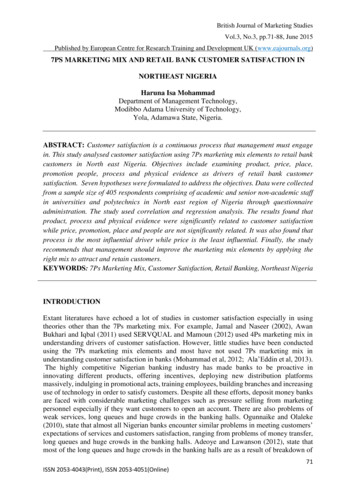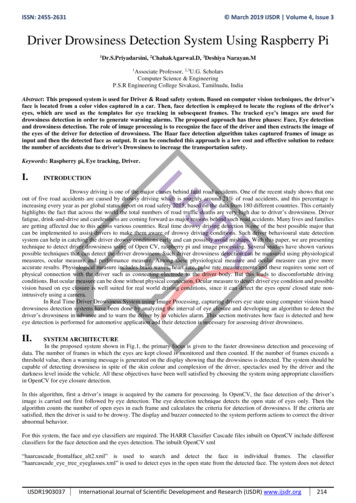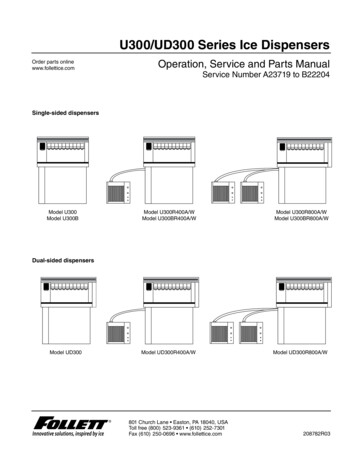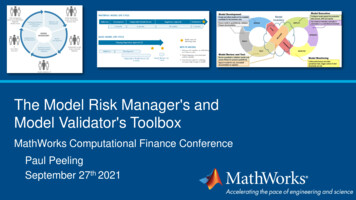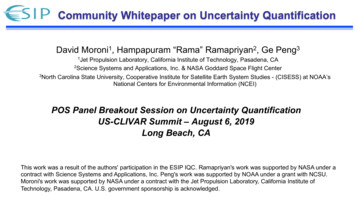
Transcription
AJOMVolume 1 Issue 2 2016Amity Journal of Operations Management1(2), (52-64) 2016 ADMAAService Quality and SERVQUAL Model: A ReappraisalBrajaballav KarKIIT School of Management, KIIT University, Bhubaneswar, Odisha, India(Received: 05/04/2016; Accepted: 14/12/2017)AbstractService sector has become the center stage of economy, with higher percentage of contribution to grossdomestic product. Demand for services has increased due to multiple factors including globalization andgrowth in demographic factors. This has necessitated understanding the characteristics and measuringservices, for sustainability and growth.There have been many attempts to measure the quality of services. But a comprehensive understanding isstill eluding. Various measures have been proposed and each has its own lacunae, nonetheless each researchhas bolstered the comprehensive understanding about service quality.In view of this dependency on context, this paper highlights the criticisms of SERVQUAL model fromthe conceptual and empirical view points. It adds to another dimensionality of ‘satiated customer’ asa proposition wherein the general perception of quality may be high, but still the customer would like toswitch service providers. This factor becomes more prominent when the service features are not specificto individual needs but overwhelms the customer with high turnaround time. The review suggests thatunderstanding the innovation quality and adaptation may be crucial in such cases.Keywords: SERVQUAL, Service Quality, Customer Satisfaction, Switch, LoyaltyJEL: L15Paper Classification: Literature ReviewIntroductionCustomer, Service process, Management, and employees are four fundamental conceptsshaping the SERVQUAL model (Parasuraman, Zeithaml, & Berry, 1988) of service quality.Customer’s have needs, experience, expectations about a particular service; management andemployees of the service providers have perceptions about customer needs; and service deliveryhas processes and specifications. Broadly speaking, these factors interact and give rise tomismatches between different pair of factors called gaps. These gaps are subsequently assessed inthe model. Primarily the gaps involve:ADMAA52Amity Journal of Operations Management
Volume 1 Issue 2 2016AJOM Customer expectations and management perceptions Perceptions of employee and management Perceptions of management and service specifications Service specifications and service delivery Service delivery and customer communication Customer expectations and perceptions of the service delivery Customer expectations and employees’ perceptionsThe following section discusses different views and criticisms of Servqual model on variousaccounts.Generalized ModelIt is argued that the model is not a generalized measure for all services; so it has to becustomized for specific services, whereas it was designed to serve as a generic measure (Carman,1990). The application of the instrument to four different service industries indicated that itis not possible to use statements exactly. Similar observation about the unsuitability of theinstrument in diverse service industries were indicated in other studies (Finn and Lamb, 1991).Three factors such as conceptualization, measure and validity of the instrument were debatedby various researchers. Cronin and Taylor (1992) raised the question about the conceptualizationand measure of service quality. It was indicated to be inadequate. The validity of the individualscale items in its ability to describe service quality components as desired was also questioned.Perception versus expectation conceptualization is equivalent to the disconfirmation model.Thus it was (Cronin and Taylor, 1994) asserted that the Servqual scale on disconfirmation-basedmodel does not measure both service quality and customer satisfaction. Many other researchers(Boulding, Kalra, Staelin, & Zeithaml, 1993; Oliver, 1993; Zeithaml, Berry and Parasuraman, 1993)also indicated that the scale is an operationalization of one of the many forms of expectancydisconfirmation model. On the other hand Buttle (1996) indicated that an attitudinal modelfor service quality is more appropriate compared to expectation disconfirmation model usedin Servqual. While evaluating two models Servqual and Servperf (Cronin and Taylor, 1992)concluded that servqual is based on satisfaction rather than attitude paradigm and also theanalysis of structural model confirms few industries rather than being generic. The model isalso criticized on being too much inductive and failing to draw concepts from different crossdisciplines (Anderson, 1992; Buttle, 1996; O’Neill and Palmer, 2003), industry specificity wouldrequire a deductive approach.One of the concerns is that the instrument is used each time for different industries, thelearning from the study is applied to another industry in subsequent research. Since the contextis changing every time, the generalizability is a difficult proposition. At the same time theinstrument is modified to suit the context of research, so it does not remain the same every time,posing another challenge for generalizability.Difference ScoresThere are issues with the difference scores of P-E gap (Brown, Churchill and Peter, 1993;Iacobucci, Grayson and Ostrom, 1994a; Page and Spreng, 2002; Prakash, 1984; Teas, 1993), thescore is obtained by the subtracting the scores in one measurement and creating a new variableto be applied in subsequent data analysis. Thus the measurement becomes questionable (Prakash,1984). Brown et al. (1993) argued that computation of such difference score measures leads toAmity Journal of Operations Management53ADMAA
AJOMVolume 1 Issue 2 2016several measurement issues like reliability, where in the positive correlation in the componentscores (e.g. expectations and performance), will get reduced in the difference. When theexpectations and perceptions instruments are administered after the service, there is a possibilityof strong correlation between them since expectation is influenced by performance. Though theproblem can be obviated to some extent (Page and Spreng, 2002), by administering the expectationinstrument prior to rendering of service, and performance instrument thereafter, it presents achallenge in many service settings.Discriminant ValidityIt indicates that constructs which are not related theoretically should also not have a veryhigh correlation among each other. This necessary condition may manifest, if the reliability ofthe construct itself is less, but in such a case, it will be for different contexts (Brown et al., 1993)secondly, the difference between P-E scores gets calculated but it actually should be a distinctconstruct. If it is calculated then it is expected to have high correlation and will not be a distinctconstruct. This presents an inherent contradiction of logic being a calculated parameter but adistinct construct. These are few reasons for which the discriminant validity of the instrumentbecomes questionable.Dimensionality ConcernsSeveral researchers have questioned the five dimensions of Servqual used as generic one,and its applicability across industries, there is also doubt about its stability (Caruana, Ewingand Ramaseshan, 2000). Individual items used have been questioned about its convergent anddiscriminant validity (Babakus and Boller, 1992; Spreng and Singh, 1993). It is also suggested thatthe different number of factors in different studies may be due to similarity across dimensionand difference within dimension (Asubonteng, McCleary and Swan, 1996). Because many studiesfailed to replicate the dimensions, it is pointed out that there is insufficient generalizability(O’Neill and Palmer, 2003). In one case it is suggested that the construct validity should be testedfor specific industry prior to measuring service quality (Finn and Lamb, 1991), further indicatinglack of generalizability. Dimensions may depend on the type of service industry (Babakus andBoller, 1992) and thus it poses complexity in developing one standard measure for all types ofservice industries. There are also suggestions (Cronin and Taylor, 1992) that the items used in thescale may be completely different from one service industry to another, depending on the level ofinvolvement of customers. Thus the fundamental arguments lack coherence and congruity for acommon measure of quality.Process OrientationThe Servqual instrument is focused on process or functional quality as opposed to technicalor outcome quality (Buttle, 1996). Completeness of twenty two item scale to measure criticaldimensions of service quality is also questioned since it focuses on human and tangible aspects(Sureshchandar, Rajendran and Anatharaman, 2002). It is argued that the dimensions likereliability, competence, and security contain outcome quality (Higgins, Ferguson and Winston,1991) and another research indicates reliability to be associated with outcome dimension(Chumpitaz and Paparoidamis, 2004).Performance-based MeasuresResearchers also have debated if the Performance-Expectation model is better measure orADMAA54Amity Journal of Operations Management
Volume 1 Issue 2 2016AJOMPerformance based measure is better. Cronin and Taylor (1992) contend that performance-basedmeasures are a better and long-term service quality measure. They compared Servqual versusperformance-only based instrument Servperf and indicate that the later has better ability toexplain variance. This was also confirmed in few other studies (Lee, Lee and Yoo, 2000; Behara,Fisher and Lemmink, 2002; Brady, Cronin, and Brand, 2002; Jain and Gupta, 2004; Sureshchandaret al. 2002).Oliver (1997), cautions that in isolation performance does not mean anything unlessanchored by a standard. Thus compared to P-E, P alone is not a logical index (Coulthard, 2004).Even if P alone is used P-E will get computed mentally by the respondents (Llosa, Chandon andOrsingher, 1998; Coulthard, 2004). Thus it become more like disconfirmation in satisfaction theoryand should be directly measured (Rust, Zahorik, and Keiningham, 1996).Although the effectiveness of Servqual has been questioned in evaluating service quality, manydo concur it to be a reasonably good predictor (Sureshchandar, et al., 2002), the gap scores are alsoindicated not to be problematic since it has more diagnostic value than performance-only scores(Parasuraman et al., 1994; Schneider and White, 2004; Spreng and Mackoy, 1996). Oliver (1993)indicates that though there is ambiguity, service quality is a comparison by the customer to thestandards of excellence.Subjective DisconfirmationDisconfirmation as the difference of scores, between performance and expectation has alsobeen debated. Disconfirmation as the difference between performance and expectation score wasquestioned by Anderson and Fornell (1994) and they proposed that the subjective disconfirmationcan be more appropriately measured directly. One such method (Peter, Churchill and Brown,1993) involved direct comparisons to operationalize disconfirmation constructs withoutcomputation of the difference. In this case the respondents have to mentally compute any suchdifference between performance and expectation and then respond about disconfirmation. Thuswhen respondents consider the gaps and respond, it can be taken as the P-E gap is operationallyand directly measured (Caruana, 1999). This way of conceptualization and operationalizationpreserves the essence of service quality along with better statistical reliability and parsimony onaccount of reduced length of the instrument.It is also suggested that disconfirmation concept can still be incorporated with expectationwording, rather than separate administration and computation of difference scores (Prakash,1984). This way of operationalization may increase statistical reliability and parsimony (Rust,Zahorik and Keiningham, 1996). To test out the disconfirmation measure in different ways,Dabholkar, Thorpe and Rentz (2000) operationalized it differently and referred “computeddisconfirmation”, and “measured disconfirmation”. In case of computed disconfirmation caseexpectation survey was conducted before the service and perception survey was after the service,thus it was a longitudinal method. Then the difference was computed. In case of measureddisconfirmation or subjective disconfirmation, the administration of questionnaire was one time,but the wording of the questionnaire altered to capture disconfirmation.Relationship between Service Quality and Customer Satisfaction“Satisfaction is a summary psychological state resulting when the emotion surroundingdisconfirmed expectations is coupled with the consumer’s prior feelings about the consumptionexperience” (Oliver, 1981). Satisfaction and service quality literature indicate that both are aboutcomparison between the service performance and some standard (Spreng and Mackoy, 1996). Itindicates interrelated concepts and process, so there is a possibility of cross fertilization of ideasAmity Journal of Operations Management55ADMAA
AJOMVolume 1 Issue 2 2016(Santos and Boote, 2003). Prior to this suggestion, Cronin and Taylor (1994), actually pointed thatthere is inconsistency in the conceptualization and such issues create difficulties and confusion.Perceived service quality is a total and long term judgment, but satisfaction is individualtransaction specific. Mostly these two concepts are taken to be synonymous whereas Croninand Taylor (1992) implore a distinction between satisfaction and service quality, arguing thatdepending on the level of involvement of customer, perceived quality and satisfaction will varyin their importance in different service industries, but a contrary argument, Caruana (2002) positsthat more attention should be paid to satisfaction, since it has more impact on customer loyalty.In another research about “Customer voice” (Iacobucci, Ostrom, and Grayson, 1995) foundthat respondents could not distinguish substantially between service quality and satisfactionand took both to be synonymous; however factors like back-office service operations, expertiseand antecedents impact the perception about service quality but factors such as timeliness,service recovery and physical environment are more likely to affect perceptions of customersatisfaction. Thus a fine tuned methodology is necessitated to distinguish satisfaction fromservice quality. Similarly a canonical model proposed (Iacobucci et al., 1996) later, suggested thatcustomer satisfaction and the service quality concepts are similar, to the extent being differentoperationalization of the evaluative judgment construct.The distinctiveness of both service quality and customer satisfaction is highlighted in manyresearches. Confirmatory factor analysis indicates (Spreng and Mackoy, 1996) these two constructsto be distinct. Another study (Dabholkar et al., 2000) finds the constructs to be distinct, but highlycorrelated and customer satisfaction is indicated to have a mediating role between perception ofservice quality and behavioral intentions of customer.It is indicated that the evaluation of excellence is attribute based, thus it is a cognitiveevaluations (Bitner, 1990; Zeithaml, 1988) process however customer satisfaction is considered tohave both cognitive and affective aspects (Dabholkar, 1995). So it is proposed to consider servicequality as predominantly cognitive judgment whereas satisfaction as emotional one (Iacobucci etal., 1994). If customer satisfaction and service quality are to be treated theoretically distinct, thenthe models depicting the antecedents and consequences must describe these (Iacobucci et al.,1996). The service quality models such as the gap model, the satisfaction models (Churchill andSurprenant, 1982; Fornell, 1992, Oliver, 1980) and extended gap model (Boulding, Kalra, Staelinand Zeithaml, 1993)), have to bring out the differences of such antecedents and consequences moreclearly.Causal OrderThe above discussion about antecedents and consequences of satisfaction also point outinherent conflicts in the explanation (Cronin and Taylor, 1992; Gotlieb, Grewal and Brown,1994; Lee et al., 2000; Spreng and Mackoy, 1996). Similarly, how customer satisfaction andservice quality is effectuated by disconfirmation is not very well understood. Many researchers(Churchill and Surprenant, 1982; Oliver, 1980; Oliver and DeSarbo, 1988; and Swan and Trawick,1981), indicate that disconfirmation influence satisfaction. Similarly other researchers (Bolton andDrew, 1991; Brown and Swartz, 1989; and Parasuraman et al., 1988) indicate that disconfirmationinfluence perceived service quality. The distinction of both was attributed to (Zeithaml et al.,1993) the operationalization of the expectations construct. It is also proposed that the perceptionof service quality is formed by comparing ideals to perceived performance on various qualitydimensions but customer satisfaction is a function of the difference between predictiveexpectations and performance along quality as well as non-quality dimensions (Oliver, 1993).ADMAA56Amity Journal of Operations Management
Volume 1 Issue 2 2016AJOMThere was an effort to distinguish expectation and disconfirmation of expectation in that the latteris proposed to influence satisfaction (Zeithaml et al., 1993). The precise nature of influences ofexpectation on service quality and satisfaction is not understood fully (Coye, 2004)There has also been debate about the causal perspectives if satisfaction causes service qualityor vice versa. Teas (1993) suggests that the causal perspectives might be understood in terms oftransaction specific or relations specific quality. One school of thought (Oliver, 1993) proposessatisfaction to be super-ordinate where as service quality is sub-ordinate, at the same time thereis a possibility that satisfaction is linked to subsequent perceptions of service quality. Thus eachsatisfying experience reinforces the previous perception.Expectancy value theory as well as ‘Attitude, Intention, Behavior’ (Bagozzi, 1992) has beenapplied to understand the nature of precedence between service quality and satisfaction (Gotlieb,Grewal and Brown, 1994). The findings indicate that the model with satisfaction as precedence isa better fit. This can be taken as a causal direction from service quality to customer satisfaction.The level of relationship between the two however does not remain the same, at the beginning itstarts at a level and then expectation goes up, thus satisfaction may come down (McAlexander,Kaldenburg, and Koenig, 1994). So a continual improvement becomes necessary. In anotheropinion (Dabholkar et al., 1995) service quality and satisfaction are distinct but highly correlatedconcepts. Within the zone of tolerance, both the concepts could overlap, but where performancefalls continually or there is high emotional contest, the causal order changes between the twoconstructs. Gronroos (1998) summarises emphatically that Perceived service quality comes first,then satisfaction with quality.Satiation and QualityQuality is indicated to be the ability to satisfy customer need. Most of the models deal witha situation where, customer expectation is higher than product’s ability. As a result there isa gap and this is indicated to be the measure of quality. But what happens when the ability ofthe product surpasses the customer need? It is indicated to be resulting in customer delight at ahigher level of customer satisfaction. However, in many situations, customer rarely plays a rolein shaping the product feature. Innovation does not solely depend on customer requirement.So the impact of such unanticipated ability of the product on customer perception of quality isworth investigation. In high technology products where the feature turnaround and obsolescenceis higher, customers may find it difficult to adapt to the complexity thus may reject the product.Similarly techno-savvy customers in a low cost scenario would like to experiment and switcheven if the current product feature meets their requirement perfectly. Such issues are indicatedin the research (Sahoo, Kar and Das, 2015) where in customer’s have indicated satisfaction withtheir current service provider yet they would like to switch the service provider. However moreresearch would substantiate the proposition subsequently.Trend of Service Quality Research in the last decade (2005-2015)Over the period SERVQUAL and its variant models have been put to test. Most of theresearches on Servqual have been about the application of its concepts, constructs and techniquesto assess the service quality in different service sector industries and organizations. Few of thediverse areas noted are: NGO (Ahuja, Mahlawat, Masood, 2011); IT (Roses, Hoppen and Henrique,2009); E-retailing (Siadat, Buyut and Selamat, 2008); Police service (Donnelly, Kerr, Rimmer andShiu, 2006); banks (Nair, Ranjith, Bose and Shri, 2010; Kumar, Tat Kee and Taap Manshor, 2009);health care (Muhammad Butt and Cyril de Run, 2010); education (Akhlaghi, Amini, and Akhlaghi,Amity Journal of Operations Management57ADMAA
AJOMVolume 1 Issue 2 20162012); tourism (Chand, 2010) and many more. In general, these have been validating differentaspects of base model and the model was adapted to the context.The extensions and variations to the model also have been put to research during this period.The relationship between service quality and customer loyalty (Albarq, 2013), service quality andcustomer satisfaction (Naeem, Akram and Saif, 2011; Krishnamurthy, SivaKumar, and Sellamuthu,2010), antecedents of customer loyalty (Boohene and Agyapong, 2011), internal customerperception (Hirmukhe, 2012) also have been worked upon. Satisfaction and intention (Kouthourisand Alexandris, 2005), Mediation effect of customer satisfaction between service quality andrepurchase intention has also been studied (Ahmed, Nawaz, Usman, Shaukat, and Ahmed, 2010)during this period.This period also has reported some quantum jumps with regard to the concept of servicequality measurement and parameters. Parasuraman, Zeithaml, and Malhotra (2005) developedan electronic Service quality model ‘E-S-Qual’ consisting of “efficiency, fulfillment, systemavailability, and privacy” parameters. Zineldin (2006) proposed a 5Qs model involving ‘qualityof object, processes, infrastructure, interaction, and atmosphere’ to assess the service quality incase of hospital. Private branding was proposed as 6th dimension of SERVQUAL model (Hersteinand Gamliel, 2006). ‘FAIRSERV’ model (Carr, 2007) based on fairness in the service transactionand relational context was also proposed. The Servqual model was extended (Kashi, Astanbous,Javidnia, and Rajabi, 2012) using quality function deployment (QFD) and Kano’s model in bankingservice, a similar attempt was also made to analyse logistics service (Baki, Sahin Basfirinci,Murat, and Cilingir, 2009). Fuzzy logic also has been tried to prioritize the library service (Jamaliand Sayyadi Tooranloo, 2009). Caro and García (2008) used a hierarchical and multidimensionalservice quality model for travel agency industry. In another research (Shieh, Wu and Huang, 2010)the instrument was used to identify the factors of importance from customer perspective and thenthe importance of each such factors were identified by using ‘decision making trial and evaluationlaboratory (DEMATEL). In a multipronged approach to evaluate service quality of hospitals,(Asadi, Mirghafoori, Sadeqhi Arani, and Khosravanian, 2011) DEA, Balanced Scorecard andSERVQUAL model also have been used. The model has been used along with performance controlmatrix to suggest improvement in service quality (Chen, Yeh, and Chen, 2011).In summary it can be seen that researchers are still validating the contextual applicability ofthe SERVQUAL model. At the same time extensions and fundamental shifts are noticed in theparadigm of measuring service quality.Scope for Future ResearchSatisfaction, causality, temporality and its benefit for the producer remain as open area ofinvestigation, especially when the turnaround time is too short. The market has become moretransient in its scope, thus the quality perception among its customers becomes more crucialfor competitive advantage. This perception is bound to undergo change during the life cycle ofthe product or service. Future research needs to investigate, how does this change over the lifecycle? In a very competitive environment, the quality would be more apt as ‘competitive quality’as the customer’s perception, expectation and experience would be relational. Similarly there is aneed for investigation into a group perspective in quality rather a purely individual perspective,as the constructs associated are formed by the cohorts. Extant research indicate that quality,satisfaction and loyalty are related but the precedence and rub-off effect is not very apparent. Aloyal customer may perceive the product or service to be of better quality than others, so the bidirectional relationship needs to be contextualized to generate meaningful understanding.ADMAA58Amity Journal of Operations Management
Volume 1 Issue 2 2016AJOMDiscussion and ConclusionThis study contributes in drawing the attention of the researcher community to few importantaspects of ‘satiated customer’, ‘competitive quality’ and bi-directionality of the associatedconstructs. It proposes that there could be impact of the cohorts on quality perception and thus theperception needs to be understood from a collective stand point rather than only from individualperspective.Service quality, customer satisfaction, loyalty and associated concepts still present challengesin terms of antecedents, consequences and causality, specifically when priorities of the dimensionsare partly impacted by contexts. One area of challenge is to take customer expectation as anindependent variable, which is hardly the case. Expectations are set by existing experience.Exposure to innovative and novel product may raise the expectation, but initially the innovationwas not from the expectation set. The rapidity with which customers are exposed to such productand higher degree of obsolescence would influence the relationship between customer satisfactionand loyalty. This would influence the temporal stability of quality dimensions. Nevertheless thequest continues for a durable and comprehensive framework to understand service quality and itsramifications in different contexts.ReferencesAhmed, I., Nawaz, M. M., Usman, A., Shaukat, M. Z., & Ahmed, N. (2010). A mediation of customersatisfaction relationship between service quality and repurchase intentions for the telecom sector inPakistan: A case study of university students. African Journal of Business Management, 4(16), 3457-3462.Ahuja, M., Mahlawat, S., & Masood, R. Z. (2011). Study Of Service Quality Management With SERVQUALModel: An Empirical Study Of Govt/Ngo’s Eye Hospitals In Haryana. Indian Journal of Commerce &Management Studies, 2(2), 310-318.Akhlaghi, E., Amini, S., & Akhlaghi, H. (2012). Evaluating educational service quality in technical andvocational colleges using SERVQUAL model. Procedia-Social and Behavioral Sciences, 46, 5285-5289.Albarq, A. N. (2013). Applying a SERVQUAL model to measure the impact of service quality on customerloyalty among local Saudi banks in Riyadh. American Journal of Industrial and Business Management, 3(08),700-707.Andersson, T. D. (1992). Another model of service quality: a model of causes and effects of service qualitytested on a case within the restaurant industry. Quality Management in Service, 3(2), 41-58.Asadi, M., Mirghafoori, H., Sadeqhi Arani, Z., & Khosravanian, H. (2011). Qualitative PerformanceEvaluation of Hospitals Using DEA, Balanced Scorecard and Servqual A Case Study of General Hospitalsof Yazd. SSUJournals, 18(6), 559-569.Asubonteng, P., McCleary, K. J., & Swan, J. E. (1996). SERVQUAL revisited: a critical review of servicequality. Journal of Services Marketing, 10(6), 62-81.Babakus, E., & Boller, G. W. (1992). An empirical assessment of the SERVQUAL scale. Journal of BusinessResearch, 24, 253-268.Bagozzi, R. P. (1992). The self-regulation of attitudes, intentions and behavior. Social Psychology Quarterly, 178204.Baki, B., Sahin Basfirinci, C., Murat AR, I., & Cilingir, Z. (2009). An application of integrating SERVQUAL andKano’s model into QFD for logistics services: a case study from Turkey. Asia Pacific Journal of Marketingand Logistics, 21(1), 106-126.Amity Journal of Operations Management59ADMAA
AJOMVolume 1 Issue 2 2016Behara, R. S., Fisher, W. W., & Lemmink, J. G. (2002). Modelling and evaluating service quality measurementusing neural networks. International Journal of Operations & Production Management, 22(10), 1162-1185.Bitner, M. J. (1990). Evaluating service encounters: the effects of physical surroundings and employeeresponses. The Journal of Marketing, 54(2), 69-82.Bolton, R. N., & Drew, J. H. (1991). A Longitudinal Analysis of the Impact of Service Changes on CustomerAttitudes. The Journal of Marketing, 55(1), 1-9.Boohene, R., & Agyapong, G. K. (2011). Analysis of the antecedents of customer loyalty of telecommunicationindustry in Ghana: The case of Vodafone (Ghana). International Business Research, 4(1), 229-240.Boulding, W., Kalra, A. Staelin, R., & Zeithaml, V. A. (1993). A dynamic process model of service quality:From expectations to behavioral intentions. Journal of Marketing Research, 30(1), 7-27.Brady, M. K., Cronin, J. J., & Brand, R. R. (2002). Performance-only measurement of service quality: areplication and extension. Journal of Business Research, 55(1), 17-31.Brown, T.J., Churchill, G.A. Jr & Peter, J.P. (1993). Improving the measurement of service quality. Journal ofRetailing, 68(1),127-39.Brown, S. W., & Swartz, T. A. (1989). A gap analysis of professional service quality. The Journal of Marketing,53(2),92-98.Buttle, F. (1996). SERVQUAL: review, critique,
common measure of quality. Process Orientation The Servqual instrument is focused on process or functional quality as opposed to technical or outcome quality (Buttle, 1996). Completeness of twenty two item scale to measure critical dimensions of service quality is also questioned since it focuses on human and tangible aspects
